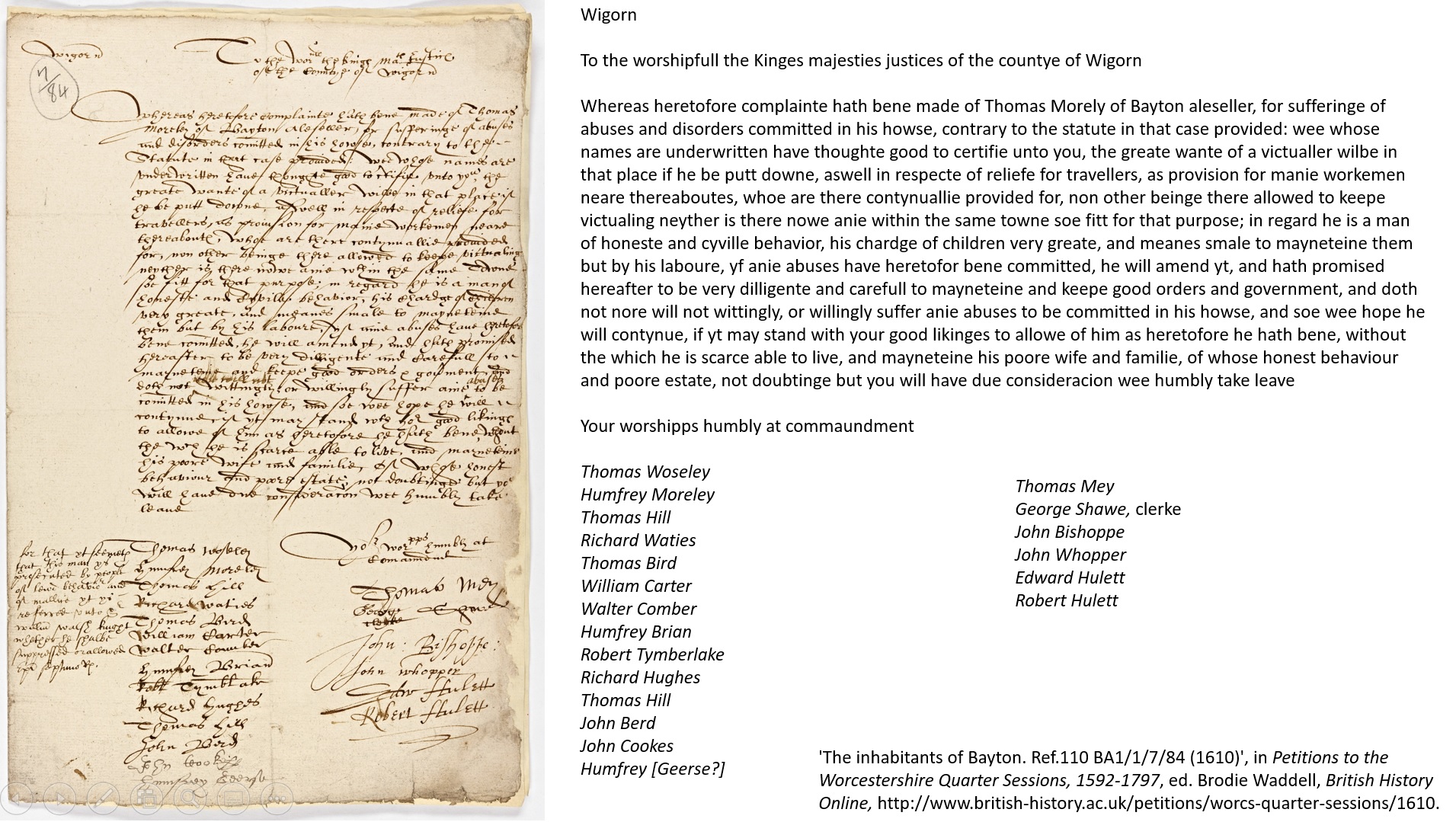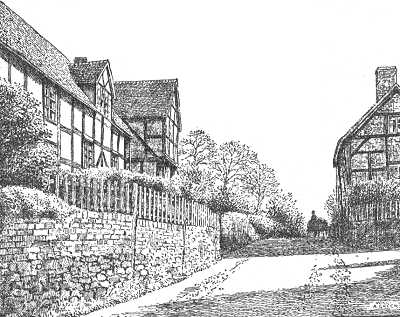Arguing about Alehouses: Local Petitions and Parish Politics in Early Modern England
Brodie Waddell (@Brodie_Waddell)
In the early seventeenth century, the parishioners of Bayton had a problem with alehouses. This small village at the edge of Worcestershire’s Wyre Forest had a population of only a couple hundred people, but disputes over local drinking establishments sparked a series of complaints and counter-complaints between 1610 and 1621 that illuminate a broader issue in the history of early modern parish politics: the rising importance of petitioning.
In 1610, or perhaps late 1609, some of Bayton’s parishioners complained to the county magistrates that an ale-seller called Thomas Morely allowed ‘abuses and disorders’ in his establishment and they asked for his alehouse to be ‘putt downe’. Soon after, twenty men of the parish signed and submitted a counter petition claiming that Morely was ‘honeste and cyville’, poor but hardworking, and without his alehouse there would be nowhere in the locality for travellers to stay or workmen to be supplied with provisions. Two years later, a group of parishioners petitioned about this again, now targeting Elizabeth, Thomas’s wife, who allegedly sold ‘extraordinary’ powerful beer very cheaply, causing all sorts of ‘disorders’ including idleness, drunkenness, violence and theft. Around the same time, nineteen named parishioners submitted similar petition against John Kempster and Thomas Bird, also claiming disorder caused by their ale-selling. Then in 1613 the churchwardens of the parish petitioned the magistrates, now complaining about Thomas and Elizabeth Morely as well as Kempster and Bird, for continuing to sell beer and causing ‘abuses’ despite a warrant issued to supress them. Finally, in 1621, eleven men signed their names to a petition accusing William Bryan and our old friend Thomas Morely of running alehouses full of ‘vagraunt’, lewd and disorderly people.

IMAGE 1: The first surviving Bayton petition, defending Thomas Morely from an earlier non-extant complaint, subscribed by 20 men, including ‘George Shawe, clerke’, in 1610. Transcribed at 'Worcestershire Quarter Sessions: 1610', in Petitions to the Worcestershire Quarter Sessions, 1592-1797, ed. Brodie Waddell, British History Online, http://www.british-history.ac.uk/petitions/worcs-quarter-sessions/1610. Image courtesy of Worcestershire Archives and Archaeology Service, Ref.110 BA1/1/7/84.
What does this flurry of complaint tell us about parish politics? It was merely an example of the rise of a broader culture of parochial petitioning, through which increasing numbers of ordinary people become heavily involved in seeking to win the support of state authorities through collective claims to represent the ‘voice of the people’ at the local level.
As part of a collaborative project on ‘The Power of Petitioning’, we have photographed, transcribed and published just over 1,400 petitions to county magistrates on British History Online. Although our initial analysis is still provisional, it appears that almost 20 percent of these petitions were from ‘the inhabitants’ of a specific place or similar collective entities and another 10 percent were by groups of named individuals. So, although there were few places quite as enthusiastic as Bayton in the early seventeenth century, the number of parishes where groups of locals banded together to petition the county magistrates was substantial and growing even before the mass petitioning campaigns of the 1640s.
These parochial requests and complaints concerned a huge range of issues, but groups of parishioners frequently focused on ‘fiscal’ issues such as eligibility for poor relief, liability for taxation or raising funds to maintain local roads and bridges. Collective petitions about alehouses – whether complaining about alehousekeepers or supporting their requests for licences – were also very common, showing the importance of new regulatory responsibilities imposed by Tudor statutes on local communities.
The Bayton petitions also allow us to look more closely at how parishioners represented themselves in their addresses to the authorities. For example, it is notable that they usually supported their claims with lists of subscribers, a practice that seems to have been relatively rare until the seventeenth century. Three of the documents together include 36 individual men’s names, with 14 of these appearing on more than one petition. Another had a subscription list which unfortunately has not survived and a fifth document – now lost – may have included still more names. Given the parish had only 30 men who contributed to the Lay Subsidy tax in 1524, it seems clear that most of Bayton’s householders probably signed their names to one or more of these petitions.

IMAGE 2: William Albert Green, ‘Bayton, Worcestershire’ (drawn 1940s), Historic Buildings in Art (n.d.) <http://www.ewgreen.org.uk/pack-b/fullpage-b/bayton-1.htm>
The language they used to describe themselves is equally revealing. In the 1610 petition, they did not use a particular label but notably referred to themselves in the first person: ‘wee whose names are underwritten’. One added his position too - ‘George Shawe, clerke’ – thus giving the subscribers a slight boost to their credibility. In 1612-13 and 1621, they again used ‘we’ and now also represented themselves as ‘the inhabitants’ and ‘the parishioners’, turning an assortment of individuals into a collective entity. Intriguingly, in 1613, only two men actually sign the petition - John Geers and Edward Sutton, churchwardens – showing how these officers took on the role of representing the entire parish in some circumstances. In contrast, the 1621 list includes one man listed as a constable among 10 others with no specified titles or occupations, rather like the clerk in the middle of the 1610 list. While it is not possible to untangle the exact meaning of these variations, the Bayton petitions suggests that both the inclusion of parochial officeholders and sheer weight of numbers were considered potentially important when trying to project an image of credible and overwhelming local public opinion.
Over the course of the early seventeenth century many, if not most, English parishes witnessed similar attempts to persuade the state authorities through collective petitioning. Groups of neighbours all across the kingdom formulated their grievances, organised subscription lists, and articulated their own role in the polity as ‘the inhabitants’ or ‘the parishioners’ of a particular community. In so doing, they not only directly shaped their own ‘little commonwealths’ but also unintentionally helped to clear a path for the immense wave of political mobilisation that swept through England in the 1640s.
Sources and Further Reading
The petitions from Bayton to the county quarter sessions are transcribed in ‘The inhabitants of Bayton. Ref.110 BA1/1/7/84 (1610)’, ‘The inhabitants of Bayton. Ref.110 BA1/1/19/85 (1612)’, ‘The inhabitants of Bayton. Ref.110 BA1/1/19/86 (1612)’, ‘The inhabitants of Bayton. Ref.110 BA1/1/20/58 (1613)’, ‘The inhabitants of Bayton. Ref.110 BA1/1/44/33 (1621)’, in Petitions to the Worcestershire Quarter Sessions, 1592-1797, ed. Brodie Waddell, British History Online, <http://www.british-history.ac.uk/petitions/worcs-quarter-sessions/>
The original petitions are held at the Worcestershire Archives and Archaeology Service, Ref.110 BA1/1/7/84; Ref.110 BA1/1/19/85; Ref.110 BA1/1/19/86; Ref.110 BA1/1/20/58; Ref.110 BA1/1/44/33.
For a brief overview of petitioning in this period, see Brodie Waddell, ‘Petitions in Early Modern England: A Very Short Introduction’, The Power of Petitioning (2019) <https://petitioning.history.ac.uk/blog/2019/06/petitions-in-early-modern-england-a-very-short-introduction/>
For the parish of Bayton itself, including population estimates, see Murray Andrews, ‘Counting people: demographic change in medieval Bayton’, Medieval Bayton (2013), <https://medievalbayton.wordpress.com/2013/12/17/counting-people-demographic-change-in-medieval-bayton/>; ‘Bayton, Worcestershire’, A Vision of Britain Through Time (n.d.) <https://www.visionofbritain.org.uk/place/9595>; 'Parishes: Bayton', in A History of the County of Worcester: Volume 4, ed. William Page and J W Willis-Bund (London, 1924), pp. 237-241, British History Online <http://www.british-history.ac.uk/vch/worcs/vol4/pp237-241>.
For alehouse politics and petitions, see Mark Hailwood, Alehouses and Good Fellowship in Early Modern England (2014), pp. 29-58, 90-94.
For a new study of anti-alehouse petitioning, see Heather Falvey, ‘‘Scandalus to all us’: presenting an anti-alehouse petition from late Elizabethan Rickmansworth (Hertfordshire)’, Rural History, 31 (2020), pp. 1-15
For a postscript with some further sources see Brodie's 26 April 2021 post on 'Powers of Petitioning'
